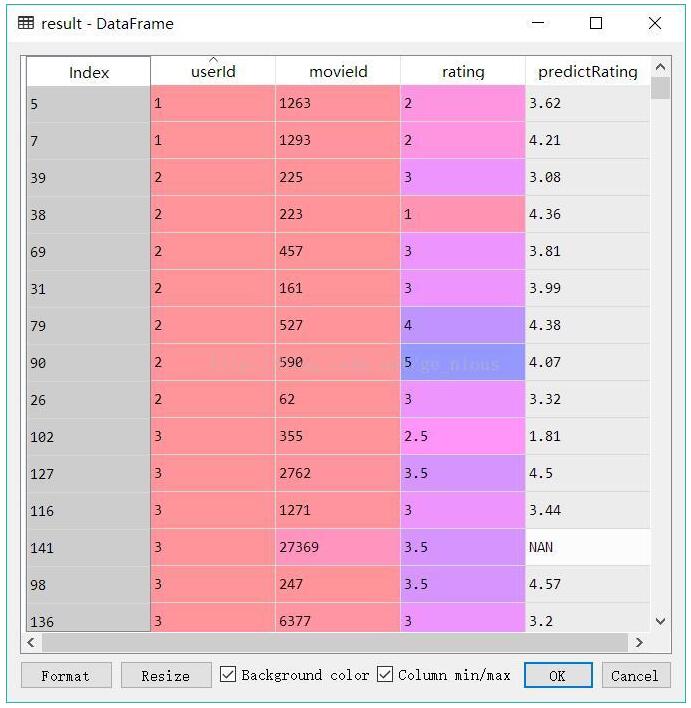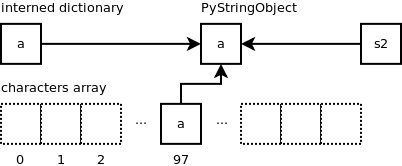基于随机梯度下降的矩阵分解推荐算法(python)
SVD是矩阵分解常用的方法,其原理为:矩阵M可以写成矩阵A、B与C相乘得到,而B可以与A或者C合并,就变成了两个元素M1与M2的矩阵相乘可以得到M。
矩阵分解推荐的思想就是基于此,将每个user和item的内在feature构成的矩阵分别表示为M1与M2,则内在feature的乘积得到M;因此我们可以利用已有数据(user对item的打分)通过随机梯度下降的方法计算出现有user和item最可能的feature对应到的M1与M2(相当于得到每个user和每个item的内在属性),这样就可以得到通过feature之间的内积得到user没有打过分的item的分数。
本文所采用的数据是movielens中的数据,且自行切割成了train和test,但是由于数据量较大,没有用到全部数据。
代码如下:
# -*- coding: utf-8 -*-
"""
Created on Mon Oct 9 19:33:00 2017
@author: wjw
"""
import pandas as pd
import numpy as np
import os
def difference(left,right,on): #求两个dataframe的差集
df = pd.merge(left,right,how='left',on=on) #参数on指的是用于连接的列索引名称
left_columns = left.columns
col_y = df.columns[-1] # 得到最后一列
df = df[df[col_y].isnull()]#得到boolean的list
df = df.iloc[:,0:left_columns.size]#得到的数据里面还有其他同列名的column
df.columns = left_columns # 重新定义columns
return df
def readfile(filepath): #读取文件,同时得到训练集和测试集
pwd = os.getcwd()#返回当前工程的工作目录
os.chdir(os.path.dirname(filepath))
#os.path.dirname()获得filepath文件的目录;chdir()切换到filepath目录下
initialData = pd.read_csv(os.path.basename(filepath))
#basename()获取指定目录的相对路径
os.chdir(pwd)#回到先前工作目录下
predData = initialData.iloc[:,0:3] #将最后一列数据去掉
newIndexData = predData.drop_duplicates()
trainData = newIndexData.sample(axis=0,frac = 0.1) #90%的数据作为训练集
testData = difference(newIndexData,trainData,['userId','movieId']).sample(axis=0,frac=0.1)
return trainData,testData
def getmodel(train):
slowRate = 0.99
preRmse = 10000000.0
max_iter = 100
features = 3
lamda = 0.2
gama = 0.01 #随机梯度下降中加入,防止更新过度
user = pd.DataFrame(train.userId.drop_duplicates(),columns=['userId']).reset_index(drop=True) #把在原来dataFrame中的索引重新设置,drop=True并抛弃
movie = pd.DataFrame(train.movieId.drop_duplicates(),columns=['movieId']).reset_index(drop=True)
userNum = user.count().loc['userId'] #671
movieNum = movie.count().loc['movieId']
userFeatures = np.random.rand(userNum,features) #构造user和movie的特征向量集合
movieFeatures = np.random.rand(movieNum,features)
#假设每个user和每个movie有3个feature
userFeaturesFrame =user.join(pd.DataFrame(userFeatures,columns = ['f1','f2','f3']))
movieFeaturesFrame =movie.join(pd.DataFrame(movieFeatures,columns= ['f1','f2','f3']))
userFeaturesFrame = userFeaturesFrame.set_index('userId')
movieFeaturesFrame = movieFeaturesFrame.set_index('movieId') #重新设置index
for i in range(max_iter):
rmse = 0
n = 0
for index,row in user.iterrows():
uId = row.userId
userFeature = userFeaturesFrame.loc[uId] #得到userFeatureFrame中对应uId的feature
u_m = train[train['userId'] == uId] #找到在train中userId点评过的movieId的data
for index,row in u_m.iterrows():
u_mId = int(row.movieId)
realRating = row.rating
movieFeature = movieFeaturesFrame.loc[u_mId]
eui = realRating-np.dot(userFeature,movieFeature)
rmse += pow(eui,2)
n += 1
userFeaturesFrame.loc[uId] += gama * (eui*movieFeature-lamda*userFeature)
movieFeaturesFrame.loc[u_mId] += gama*(eui*userFeature-lamda*movieFeature)
nowRmse = np.sqrt(rmse*1.0/n)
print('step:%f,rmse:%f'%((i+1),nowRmse))
if nowRmse<preRmse:
preRmse = nowRmse
elif nowRmse<0.5:
break
elif nowRmse-preRmse<=0.001:
break
gama*=slowRate
return userFeaturesFrame,movieFeaturesFrame
def evaluate(userFeaturesFrame,movieFeaturesFrame,test):
test['predictRating']='NAN' # 新增一列
for index,row in test.iterrows():
print(index)
userId = row.userId
movieId = row.movieId
if userId not in userFeaturesFrame.index or movieId not in movieFeaturesFrame.index:
continue
userFeature = userFeaturesFrame.loc[userId]
movieFeature = movieFeaturesFrame.loc[movieId]
test.loc[index,'predictRating'] = np.dot(userFeature,movieFeature) #不定位到不能修改值
return test
if __name__ == "__main__":
filepath = r"E:\学习\研究生\推荐系统\ml-latest-small\ratings.csv"
train,test = readfile(filepath)
userFeaturesFrame,movieFeaturesFrame = getmodel(train)
result = evaluate(userFeaturesFrame,movieFeaturesFrame,test)
在test中得到的结果为:

NAN则是训练集中没有的数据
以上就是本文的全部内容,希望对大家的学习有所帮助,也希望大家多多支持【听图阁-专注于Python设计】。

